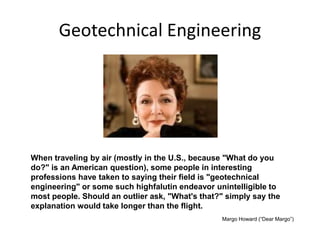Things about Geotheta
Things about Geotheta
Blog Article
Some Ideas on Geotheta You Should Know
Table of ContentsNot known Factual Statements About Geotheta Geotheta Things To Know Before You Get ThisThe 8-Minute Rule for GeothetaThe Definitive Guide to Geotheta
They team up with civil engineers, structural engineers, designers, and various other experts to incorporate geotechnical factors to consider into the overall task layout and building procedure. This needs reliable teamwork, sychronisation, and interaction to ensure that the geotechnical elements align with the task goals and meet regulatory demands.Mining & Materials Design: Concepts of drilling, infiltration prices, and elements influencing the choice of boring approach. Blasting methods in surface area and below ground workings. Mechanical and continual methods to fragmentation, consisting of longwall shearing and fullface boring.
Integrated evaluation of fragmentation and comminution procedures. Used by: Mining & Materials Engineering.
The Main Principles Of Geotheta
Bachelor's level programs in civil, geotechnical, geological, and ecological design typically last four years and consist of basic education training courses in English, social science, and the humanities, in addition to courses in innovative maths, architectural geology, and liquid mineralogy. (https://www.indiegogo.com/individuals/37984319)
Geotechnical design entails the evaluation of the dirt and rock conditions at a particular website, and their ramifications for the growth of that website. As a lot of structures count on the ground for support, it lacks surprise that an in-depth understanding of the ground conditions, and the viability of foundation systems, are essential to the long-lasting stability and efficiency of the structure or structure.
Being experts in the examination of geological developments and ground practices, geotechnical designers do clinical examinations and screening to understand the effect these geological developments may carry the layout and construction of building, civil and framework projects. This knowledge is vital for the layout and construction of structures, roads, passages, dams, bridges, and supply of water and sewer system.
The geotechnical group at Douglas Partners routinely seek advice from architects, layout engineers, developers, and contractors to make suggestions on style and growth proposals to make sure that the developed frameworks are suitably designed for the ground problems. For instance, the layout of footing systems needs to take into consideration the weight of the structure, the ability of the ground to support that weight along with motion tolerances and reliable building.
What Does Geotheta Do?
This job is significantly simplified by the use of our Douglas Map geospatial platform that makes this info readily easily accessible in a simple to make use of web browser user interface. A geotechnical designer will direct the boring of boreholes and examination pits to collect dirt and other examples, and also analyze surface area features and ground direct exposures to form a geotechnical model of the subsurface conditions.
Depending upon the task kind and ground conditions ran into, research laboratory testing may to name a few things examine stamina, compressibility, sensitivity and/or leaks in the structure of soil and rock examples. After this data is gathered and collated, the results are used for a geotechnical design of the site, which is commonly provided as areas throughout the site.

A geotechnical investigation naturally can just evaluate the ground conditions at the locations drilled or dug deep into. All-natural variants in soil and rock conditions can take place across a website and between test areas. It is as a result great technique that the geotechnical designer be maintained throughout building of the job to give on-site verification that the ground conditions experienced follow the expectations and recommendations provided in the geotechnical examination record.
Not known Incorrect Statements About Geotheta
Geotechnical engineers use their comprehensive expertise of dirt and rock to evaluate risk and solve issues on varied infrastructure projectsGeotechnical design is a specialist branch of civil design which looks at the practices of earth products and the application of dirt and rock technicians. Tailings Engineer. As a geotechnical engineer, you will assess the physical, mechanical and chemical buildings of dirt and rock in order to design structures, retaining structures and earthworks
Geotechnical engineering is carefully linked to and overlaps with, both design geology and ground design - https://geotheta.start.page. It's feasible to be experts in geotechnics or job for a geotechnical business yet be recognized as a design geologist or a ground designer. As a geotechnical engineer, you'll need to: develop and keep connections with clients and various other professionals involved in the site, throughout each projectmaintain security criteria on site be conscious of cost ramifications when you make recommendationsstudy geological maps and airborne pictures from a variety of resources and from various time periodsexamine building plans to see just how viable they are based on your understanding of the siteinvestigate threats or geological dangers for the sitesearch for eco delicate attributes, such as garbage dump beginning to establish factual and expository ground modelsplan field investigationsdrill and evaluate examples of bedrock, soil, groundwater and extra materials supervise other professionals on sitesolve technological concerns as they develop, such as unanticipated structures at drill sitesmonitor problems during and after building and construction to make certain structures are Look At This secure in the brief and lengthy termadding information collected on site to your first researchcreating geotechnical computations, illustrations, and 2 or three-dimensional computer system models analyzing the datamaking recommendations regarding the proposed use the site

Report this page